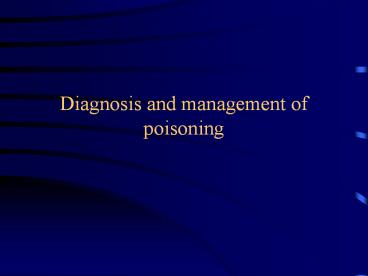Diagnosis and management of poisoning - PowerPoint PPT Presentation
Title: Diagnosis and management of poisoning
1
Diagnosis and management of poisoning
2
Agents involved in poisoning National Poisons
Information Service (NPIS) enquiries
3
Patient age
4
Age and poisonings
- Children (lt 5years)
- Accidental/household products/usually low
toxicity - Adults
- Usually para-suicide with readily available drugs
- Most need little/no medical intervention
- Elderly
- Often significant psychiatric problems
- Access to more prescription drugs of higher
toxicity - Tolerate poisonings less well
5
Common agents in adult overdoses
- OTC drugs (paracetamol/NSAID/vitamins)
- Alcohol
- Pyschotropic drugs (TCAs, SSRIs, major
tranquillisers, benzodiazepines, lithium) - Street drugs (heroin)
6
Common features in adult overdoses
- Para-suicide
- Readily available agents
- Frequently in combination
- Frequently combined with alcohol
7
Poisoning clinical approachHistory
- What has the patient taken and when?
- Where and under what circumstances has the
self-harm occurred? - Why has the patient self-harmed?
- Is this a repeat episode?
- Previous psychiatric or sociopathic history?
8
Poisoning clinical approachHistory
- The type and quantity of drug(s) taken is (are)
almost always known. - (Volunteered by patient, known to
relatives/friends or empty bottles).
9
Poisoning clinical approachHistory
- Was the patient likely to be found quickly after
the episode of self-harm? - Considered or impetuous episode of self- harm?
- Drunk?
- Suicide note?
10
Poisoning clinical approachHistory
- Why?
- Family or interpersonal disagreement?
- Psychiatric symptoms or history?
- Sociopath?
- Serial self-harm?
11
Poisoning clinical approachExamination
- Usually perfectly well or drunk
- Conscious level
- Integrity of airway
- Cardio- respiratory
- Urine output
12
Poisoning clinical approachinvestigations
- Routinely, SaO2, U/E/LFT, FBC, ECG
- Specific toxicological tests
- Unknown drug screens
13
Diagnosis of poisoningspecific toxicological
tests
- Prognostic information
- Need for elimination therapy
- Need for antidote
14
Specific toxicological investigations
- Paracetamol
- Aspirin
- Iron
- Theophylline
- Lithium
- Digoxin
- (Ethanol/alcohols/glycols)
15
Repeated drug levels
- Aspirin
- Theophylline
- Lithium
16
Diagnosis of poisoning unknown drug screens
- Usually not available in appropriate time scale
- Usually of little or no clinical value, so
discuss with laboratory/NPIS - Coma is not an indication for drug screening
- Consider in those who are thought to have
overdosed with unknown drugs and are clinically
unstable - Save urine and blood for critically ill cases (HM
Coroner)
17
Poisoning clinical approachso what do I do
next
- Is this serious?
- What additional tests do I need?
- Whats the clinical management?
18
Poisoning clinical approachso what do I do
next
- TOXBASE
- www.spib.axl.co.uk/
19
National Poisons Information Service (NPIS)
- Managed network of centres
- Belfast, Birmingham, Cardiff, Edinburgh, London,
Newcastle - TOXBASE as first tier database
- Single phone number 0870 600 6266
20
Clinical management of the poisoned patient
- Observation/supportive
- Techniques to prevent drug absorption
- Techniques to eliminate the drug(s)
- Antidotes
21
Gut decontamination
- Syrup of ipecac
- Gastric lavage
- Activated charcoal
22
Elimination techniques
- Repeat dose activated charcoal
- Urinary alkalinisation/acidification
- Dialysis
23
Antidotes
- N-acetyl cysteine (Paracetamol)
- Naloxone (Opiates)
- Flumazenil (Benzodiazepines)
- Desferrioxamine (Iron)
- Digibind (Digoxin)
- Pralidoxime (Organophosphates)
24
Some common clinical presentations
25
Paracetamol
26
Paracetamolstandard management
- Toxic paracetamol concentration
- N acetyl cysteine (NAC, Parvolex 300mg/Kg over 20
hours - Check INR/creatinine before discharge
27
Paracetamol
- High-risk patients
- Alcoholics
- Co-prescription enzyme-inducing drugs
- Starvation/anorexia
28
Paracetamol late presentation
- Prolonged NAC infusion
- Standard 300 mg/kg over 20 hours
- Prolonged standard course
- (150 mg/kg over 16 hours)n
- Monitor urine output
- Monitor INR
- Monitor blood glucose
29
Paracetamol prognosis
- Usual biochemical LFTs are not related to outcome
- Poor prognosis (80 - 90 mortality) if
- pH lt 7.3 or
- creatinine gt 300 ?mol/L PT gt 100 secs
- grade 3/4 encephalopathy
30
Ethanol
- Very common
- Clinical effects of any given blood ethanol
concentration vary with prior experience of
ethanol use/abuse
31
Alcohol dehydrogenase metabolism
Alcohol dehydrogenase
Aldehyde dehydrogenase
Ethanol
Acetaldehyde
Acetate
32
(No Transcript)
33
Ethanol intoxication
- Central nervous system
- Excitation
- Obtunded
- Metabolic
- Hypoglycaemia
- Metabolic acidosis
- Fluid/electrolyte disturbances
34
Ethanol intoxicationclinical management
- Maintain airway patency
- Avoid inhalation of vomitus
- Intravenous fluids
- Monitor blood glucose and pH
35
Tricyclic anti-depressants
- Coma/convulsions/cardiac dysrrhythmias
- Serious overdoses coma, ECG abnormalities (QRS
prolongation), serum total tricyclic
anti-depressant levels gt 1000 ?g/L
36
Opiates
- Respiratory depression
- Hypoxia/anoxic brain damage
- SaO2, PaO2
- Naloxone (infusion)
- Rhabdomyolysis
- Compartment syndrome/myoglobinuria
- CPK
37
Benzodiazepines
- Coma
- Often prolonged (especially elderly)
- Respiratory depression unusual unless
- mixed overdose with other CNS depressants
38
Amphetamines/Ecstasy(MDMA)
- Agitation/delirium/coma
- Hypertension/tachycardia/mydriasis
- Hyperpyrexia
- AST/CPK elevated
- Rarely DIC, hyponatraemia, multi-organ failure































